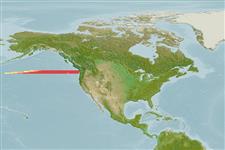Teleostei (teleosts) >
Myctophiformes (Lanternfishes) >
Myctophidae (Lanternfishes) > Myctophinae
Etymology: Protomyctophum: Greek, pro = first, in front of + Greek, mykter, -eros = nose + Greek, ophys = serpent (Ref. 45335).
Environment: milieu / climate zone / depth range / distribution range
Ecology
Marine; pelagic-oceanic; depth range 100 - 500 m (Ref. 51600). Temperate; 48°N - 46°N
Northwest Pacific: off Tôhoku in Japan. Northeast Pacific: south of southern California to Washington (Ref. 265). Also widespread in the transition region between the subarctic and central water masses of the North Pacific.
Size / Weight / Age
Maturity: Lm ? range ? - ? cm
Max length : 3.7 cm SL male/unsexed; (Ref. 28981)
Epipelagic to mesopelagic (Ref. 31442). Oviparous, with planktonic eggs and larvae (Ref. 31442).
Life cycle and mating behavior
Maturities | Reproduction | Spawnings | Egg(s) | Fecundities | Larvae
Matarese, A.C., A.W. Kendall, D.M. Blood and M.V. Vinter, 1989. Laboratory guide to early life history stages of Northeast Pacific fishes. NOAA Tech. Rep. NMFS 80:1-652. (Ref. 265)
IUCN Red List Status (Ref. 130435)
Threat to humans
Harmless
Human uses
Tools
Special reports
Download XML
Internet sources
Estimates based on models
Preferred temperature (Ref.
123201): 2.8 - 8.8, mean 4.6 °C (based on 9 cells).
Phylogenetic diversity index (Ref.
82804): PD
50 = 0.5000 [Uniqueness, from 0.5 = low to 2.0 = high].
Bayesian length-weight: a=0.00871 (0.00387 - 0.01962), b=3.11 (2.92 - 3.30), in cm total length, based on LWR estimates for this (Sub)family-body shape (Ref.
93245).
Trophic level (Ref.
69278): 3.2 ±0.5 se; based on size and trophs of closest relatives
Resilience (Ref.
120179): High, minimum population doubling time less than 15 months (Preliminary K or Fecundity.).
Fishing Vulnerability (Ref.
59153): Low vulnerability (10 of 100).
